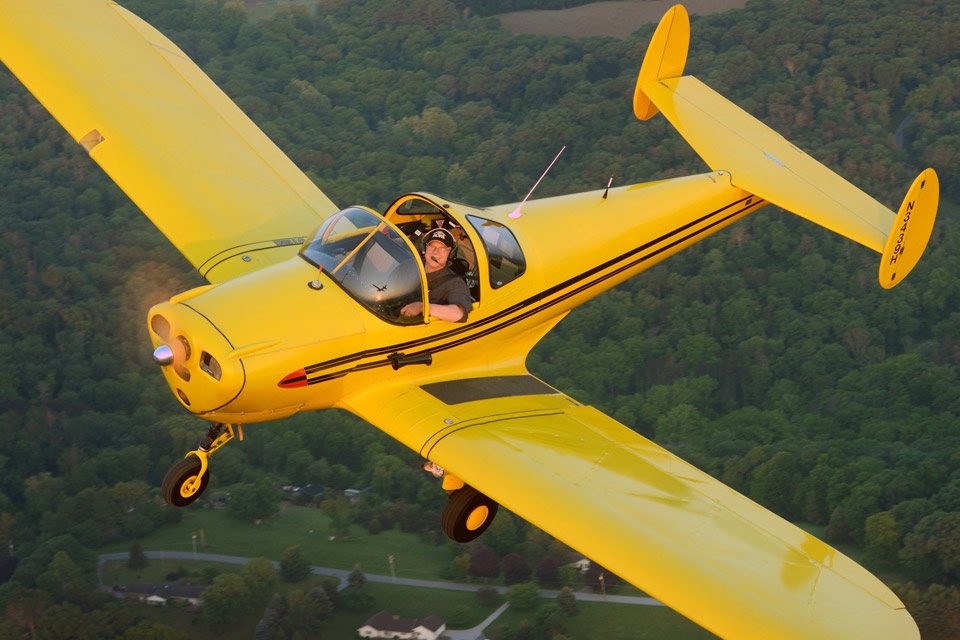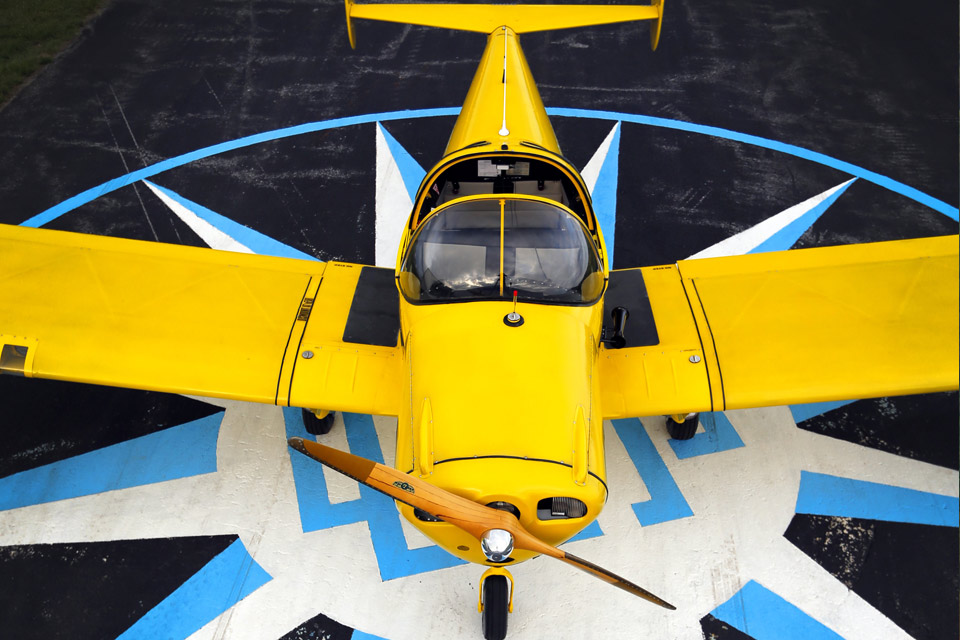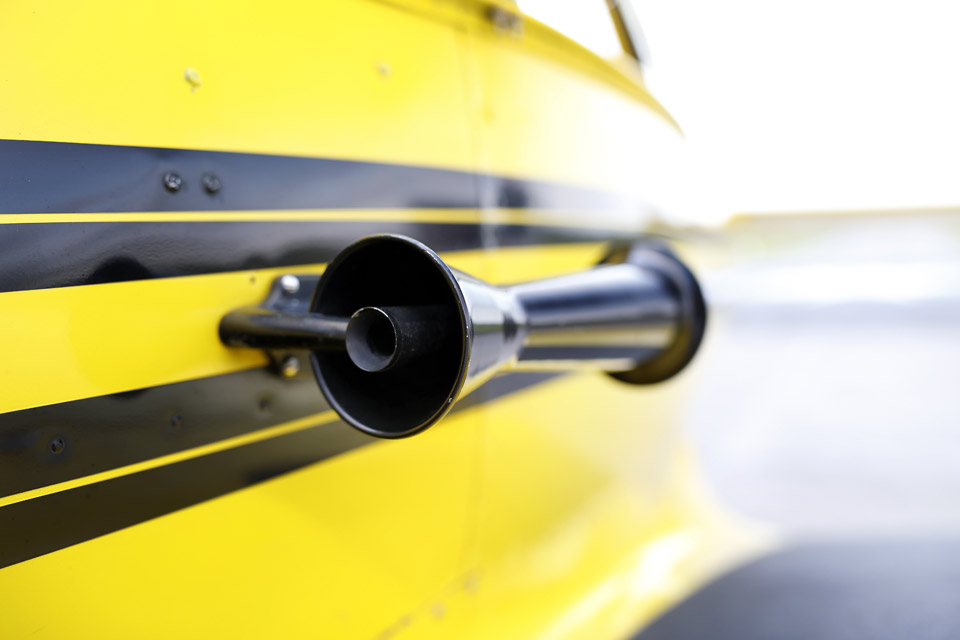75th anniversary of the Ercoupe: Friendly flyer
Flying a top-down, two-seat classic
With its round, roly-poly lines; diminutive size; and slide-down canopy; the Ercoupe is a crowd magnet for young and old alike. It’s a friendly looking airplane that would seem right at home with a smiley face painted on its cowl. This stands to reason, because the Ercoupe was designed to have good manners. Back in 1939 a young designer named Fred Weick came up with the Ercoupe as a way to win a safety prize, which he did.
Back then, stalls and spins claimed many more lives than today, so Weick’s Ercoupe was given limited elevator travel (13 degrees up, in the early models) and a wing design that makes it incapable of stalling or spinning. Well, at least not held in a stall in which the wings are entirely stalled. You could do a hammerhead or whip stall, but the turbulent airflow from the stalled wing roots would disrupt the air moving over the elevator. This, together with the limited elevator travel, means that there would be insufficient elevator authority to maintain the airplane in even an aggravated stall. The airplane can, however, mush earthwards in a sprightly manner, which helps to explain why it has no flaps.
The Ercoupe has other admirable features. The wings’ large dihedral means good roll stability. The Constellation-style twin vertical stabilizers fly in air undisturbed by propeller slipstream, so there is minimal p-factor. The trailing-link main landing gear mean smoother landings. And the tricycle-gear arrangement—revolutionary in 1939—promised an end to the ground loops and botched crosswind takeoffs and landings that are the curse of taildraggers. And in a nod to automobile design, the Ercoupe has a control yoke that does triple duty, controlling pitch, roll—and nosewheel steering. Want to brake? Step on the single, floor-mounted brake pedal. Early model Ercoupes didn’t come with rudder pedals—don’t need ’em! (elevator and rudders are interconnected)—but they were available as an option.
Since it first went into production in 1940, records show that 5,600 Ercoupes of various varieties were sold. The Engineering and Research Corporation (ERCO) of Riverdale, Maryland, built 112 original Ercoupes in 1940 and 1941, delivering them from the company’s own airport. Then came a pause during World War II. But the blockbuster sales came when production resumed after the war in 1946; that’s the year ERCO delivered 4,311 Ercoupes. These were the model 415-C, which had a max takeoff weight of 1,260 pounds and 75-horsepower Continental C-75 engines. Price new: $2,665. Ercoupes were everywhere back then. Macy’s department stores even had them on display. For a few heady months it seemed that predictions of wartime pilots wanting to continue flying in civilian life were coming true. But a recession dealt a blow to sales. In 1947, just 77 Ercoupes were sold.
Thus ended the golden age of Ercoupe production. After 1950, a succession of owners turned out ever-fewer Ercoupes. When production ended in 1970, Mooney Aircraft was making Ercoupes the company rebranded as Mooney M10 Cadets, complete with Mooney’s signature forward-swept vertical stabilizer. Only 59 Cadets were sold. Then Mooney sold the type certificate to Univair Aircraft Corporation of Aurora, Colorado, where it remains today.
To many, the 1946 415-C is the most desirable Ercoupe. For one, the 415-C is light enough to be flown under Light Sport aircraft (LSA) rules. Others prefer those with hikes in engine power. The models 415-E through -G came with 85-horsepower Continentals, 90-horsepower engines were on those produced after 1958, and there’s an STC to install a 100-horsepower Continental O-200. A slide-back canopy replaced the original slide-down canopy side panels beginning in 1964. Aluminum wing skins and, over the years, changes to a split-elevator design; a double-fork nosewheel; Cleveland brakes; and other minor changes were introduced. And then there’s the rudder-pedal mod, which isn’t really necessary unless you are learning to fly in an Ercoupe and don’t want a limitation to no-rudder-pedal flying on your certificate.
I’ve always had a soft spot for Ercoupes, and over the years I’ve flown them intermittently. When I started flying I flew a 415-C that a coworker owned. That was a good deal until the day I experienced two engine stoppages. Then there was a well-worn yellow Ercoupe (most are bare aluminum) that a mechanic friend let me fly back in the 1980s. That one was on the cover of AOPA Pilot back in the day. More recently I checked out in a nice yellow 415-C that was on an FBO’s rental line, and I flew that a while. Then it disappeared.
Until the day I drove by the ramp next to the AOPA building and saw it—in Gene Olinger’s hangar. Olinger, a scientist at Frederick’s nearby United States Army Medical Research Institute for Infectious Diseases, had owned the airplane all along. But he pulled it off the rental line after a number of dead-battery, scratched-windshield, and electrical-short incidents. Oh, and someone spilled oil in the baggage compartment.
Olinger bought his ’Coupe for $23,000 in 2004, and hoped to defray costs by having a partner, then leasing it to the FBO. But the wear and tear of renting got to him, so he ditched his partner, ditched the FBO, and began a restoration process on the 2,000-hour airplane. “The airplane needed an owner, not a renter,” Olinger said.
Then began 18 months of downtime while he addressed the maintenance issues. He inspected all the structural components, replaced control rods that showed signs of corrosion, added pulse lights, and overhauled the instrument panel. The panel is still bare-bones, but Olinger upgraded to a “glass cockpit” by installing an iPad mini running ForeFlight and a Stratus 2 ADS-B receiver. When he needed parts he called on Univair. For any other sort of advice there is the excellent and authoritative Ercoupe Owners Club.
The best news of all? There was no corrosion of the wing spars, ribs, or wing spar box. These are areas prone to corrosion, because of dissimilar metals at the wing attach points—and the wings’ dihedral, which promotes moisture drainage. Oh, and there’s the problem of mouse urine. Don’t laugh—it’s acidic, and after decades can render an Ercoupe unairworthy. Ercoupes with aluminum or Ceconite wing coverings are extremely susceptible to spar corrosion because moisture is sealed inside. Fabric wings, like the ones on Olinger’s airplane, breathe so condensation is more apt to wick away—unless the airplane is kept outside. Even so, there are major airworthiness directives, AD 2002-26-02 and AD 2003-21-01, which mandate inspections for corrosion, unless you install 16 inspection panels. Or pull the wings, your choice.
The little Ercoupe oddities take some getting used to, but the memories kept coming back after climbing into the cockpit with Olinger. Hop up on the wing. Slide down the windows. Step on the seat and ease into the front office, the panel a few inches from your face. Olinger has the rudder pedal conversion, which means no single brake pedal, which means set the single hand brake. Prime the engine, turn on the magnetos, and pull the starter knob. After it starts, release the brake and taxi to the runway.
Using the yoke to make taxi turns does feel odd at first. You can push on the rudder pedals all you want, but they don’t have brakes and they aren’t connected to the nosewheel. So you drive it like a car but use the panel-mount brake to slow down.
Takeoffs are stone simple. Grab the huge ball of a throttle control and mash it forward, steer with the yoke as you wait for 70 mph, give a slight tug, and you’re off. Olinger likes to accelerate in ground effect, then enter a 75-mph climb. In crosswinds the upwind wing may rise, but you’re supposed to keep the nosewheel steering down the runway, being careful not to let the nose pitch up, lest the airplane pivot into the wind on its main gear.
Soon we’re over the fields and ridges of central Maryland, windows down, and flying with arms perched on the window sill—like you do when driving a car in the summer. I once heard that if you stick your arm out into the wind—careful, now—the airplane would turn in that direction. It works.
The pilot’s operating handbook, a laughably short compendium, gives little hard information on cruise performance, but I’m guessing we’re doing 100 mph and burning maybe five gph in the process. A fire tower slides by, then a park filled with weekend visitors. That’s what the Ercoupe is all about—fun, relaxed flying. Olinger has logged 500 hours in his airplane, and while he has taken it on long cross-countries, its main purpose is tooling around locally.
There was a crosswind, so for the landing we’d be putting the Ercoupe in a crab, which is what the flight manual urges. On approach, the number is 70 mph. I stayed crabbed until main gear touchdown, at which time I relaxed back pressure on the yoke, let the nosewheel touch down, and finished the landing by ground steering with the yoke and braking with the hand brake. It certainly feels odd but I suppose ERCO felt it preferable to a ground loop.
The flight manual says that if you’re high on final you can lose a lot of altitude by tempting fate thusly—roll the airplane 20 to 30 degrees, all the while holding full aft yoke until reaching 200 feet agl, then pitching to 60 mph in time to get airspeed for the flare and landing. Yow! The Ercoupe will sink mightily anyway, which helps explain some of its hard-landing accidents. But if I’m ever high on final you won’t see me mushing earthwards in a bank.
While Ercoupes are inexpensive and promise low-cost fun flying, bigger issues loom. The dwindling fleet is 75 years old, and their owners are getting up in years as well. There’s plenty of deferred maintenance, corrosion never sleeps, and skinflint owners sometimes simply don’t give the airplane the TLC it deserves. And there’s always been a cohort that actually demeans the Ercoupe for its tame behavior; to this group the Ercoupe isn’t a “real” airplane.
But thanks to enthusiasts like Olinger, the brand soldiers on. With more like him the airplane will always be an enduring classic, and a flying piece of aviation history. Fred Weick—who went on to work for Piper, where he designed the Pawnee and Cherokee line of light singles—would like that. AOPA
Email [email protected]
ODD ’COUPES
Twin Ercoupe. In 1946, the Thrasher Brothers Flying Circus of Athens, Georgia, fused two Ercoupes, creating a one-off twin-fuselage, twin-engine model they used in their airshow. This hybrid was modified so it could perform spins and loops.
The JATO-powered Ercoupe. Don’t laugh. In August 1941 the U.S. Army attached jet-assisted takeoff (JATO) rocket engines to an Ercoupe and flew it at California’s March Field. Some say it was the United States’ first test of a JATO airplane. The takeoff run lasted just 7.5 seconds and the Ercoupe got off the ground in 300 feet.
The Bryan Autoplane. In 1953 Leland Bryan used an Ercoupe fuselage and twin tail, melded it with folding wings and a pusher engine, and made three versions of a roadable airplane. The third version crashed in 1974, killing him ().
Lasher Little Thumper. Using an Ercoupe fuselage and wings, together with an Aeronca Champ aft fuselage, C.W. Lasher made the “Little Thumper” open-cockpit taildragger.
SPEC SHEET
ERCO Ercoupe Model 415-C
Specifications
Length | 20 ft 9 in
Wingspan | 30 ft 0 in
Height | 5 ft 11 in
Wing area | 142.6 sq ft
Empty weight | 749 lb
Useful load | 511 lb
Max takeoff weight | 1,260 lb
Powerplant | Continental C-75-12, 75 hp at 2,300 rpm
Performance
VNE (never exceed speed) | 125 knots
Max speed | 96 knots
Cruise speed | 83 knots
VS (stall speed) | 42 knots
Range | 261 nm
Service ceiling | 13,000 ft
Rate of climb | 550 ft/min
Wing loading | 8.84 lb/sq ft
Power loading | 16.8 lb/hp
Extra: View the video.

















